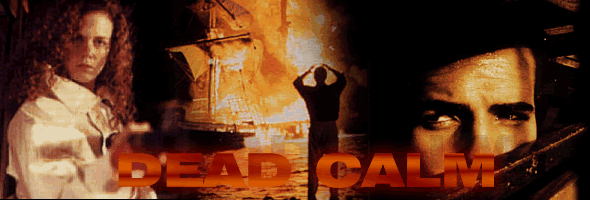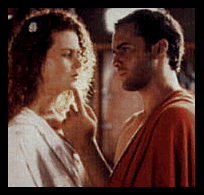
Color, 1989, 95 mins. Directed by Phillip Noyce
Starring Nicole Kidman, Sam Neill, Billy Zane / Written by Terry Hayes / Produced by Terry Hayes, George Miller, and Doug Mitchell / Music by Graeme Revell / Cinematography by Dean Semler
Format: DVD - Warner (MSRP $19.95)
Letterboxed (2.35:1) (16x9 enhanced) / Dolby Digital 2.0
A breakthrough film for almost everyone involved, Dead Calm only lasted briefly in theaters but won a loyal audience on home video and cable. Nicole Kidman became a familiar face, Billy Zane (Titanic) played the first of his gonzo nautical villains, and director Phillip Noyce (the Harrison Ford/Tom Clancy films) finally had a hit after toiling in cable TV and unseen art house projects. The fuss is easy to understand, as Dead Calm remains a taut if imperfect little thriller and a compelling stylistic exercise, filled with gorgeous widescreen scenery and earnest performances.
Essentially an updating of the old Orpheus myth filtered through Roman Polanski's Knife in the Water, the film introduces a married couple, John (Sam Neill) and Rae (Nicole Kidman), out boating in the Pacific Ocean to recuperate from the death of their son in a violent car accident. One day John spies a man in a small lifeboat rowing towards them from a distant ship. The stranger, Hughie (Billy Zane), tells them that his boat is sinking and that he is the only survivor.
As might be expected from the presence of George Miller (Mad Max) behind the scenes, Dead Calm is a very riveting film for anyone who can tolerate the claustrophobic settings and threadbare plotline. Few surprises actually emerge during the film, but the pleasures lie mostly in watching the performers interact. Kidman is a particular revelation, with her fiery hair and porcelain features making her an ideal heroine. Some of her decisions during the film are astonishingly stupid (tying up and subduing Hughie on several occasions rather than simply killing him, for example), but it's to Kidman's credit that the character always works and never loses audience sympathy. Neill has little to do after the first twenty minutes besides scrambling around in the water, but he's efficient and appealing as always. The underrated Graeme Revell contributes an astonishing score filled with tribal percussion and eerie soprano voices; its unavailability on CD is a true crime. The film's only glaring flaw is its essential lack of depth, a factor that could have been avoided with a denser screenplay. Originally slated and partially filmed as an Orson Welles project with Laurence Harvey back in the 1950s, the story (from a Charles Williams novel) contains some tantalizing basic ideas, such as Rae (the Eurydice figure) fighting Hughie ("death") while her husband literally goes into the "underworld" (the watery ship) to find the truth. Had the filmmakers sacrificed one or two chase scenes in favor of character development, Dead Calm could have been a masterpiece, but what remains is still more than worthwhile.
Warner's long delayed DVD spawned a number of rumors since its initial announcement, mostly involved scenes cut from the final assembly and a commentary track. Alas, the DVD is virtually bare bones, with only the U.S. trailer as any kind of bonus. Fortunately the transfer itself makes up for this loss, as Warner has gone to quite a bit of trouble improving on their dismal laserdisc release. Issued back at the dawn of letterboxing, the laser featured a heavily compromised 1.85:1 transfer of this scope film, but the DVD thankfully restores the entire width of the picture. Given the careful and expansive compositions used throughout, this presentation is crucial to enjoying Dead Calm, and the brilliant bursts of color throughout look fresh and free of any distortion. The soundtrack is still straight Dolby Surround, but the startling channel separation offers a few nifty showcases for audiophiles, especially all of the flare-shooting scenes.
 John takes off to investigate the seemingly deserted ship, which is gradually sinking, and uncovers a horrific secret. Meanwhile the charismatic but quite insane Hughie stalks and terrorizes Rae, who must use all means at her disposal to regain the ship and rescue her husband from a watery death.
John takes off to investigate the seemingly deserted ship, which is gradually sinking, and uncovers a horrific secret. Meanwhile the charismatic but quite insane Hughie stalks and terrorizes Rae, who must use all means at her disposal to regain the ship and rescue her husband from a watery death.
